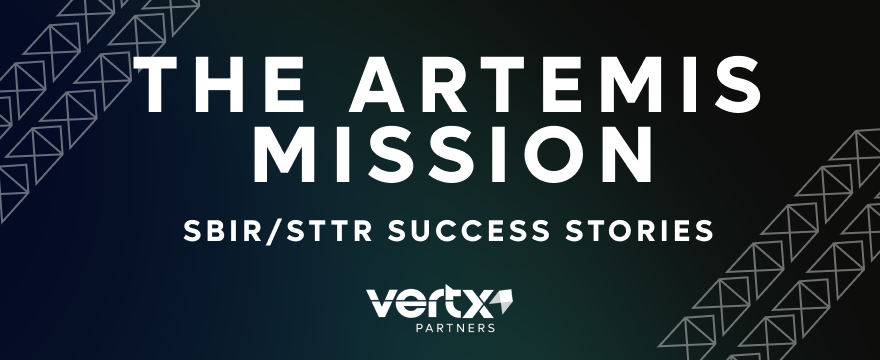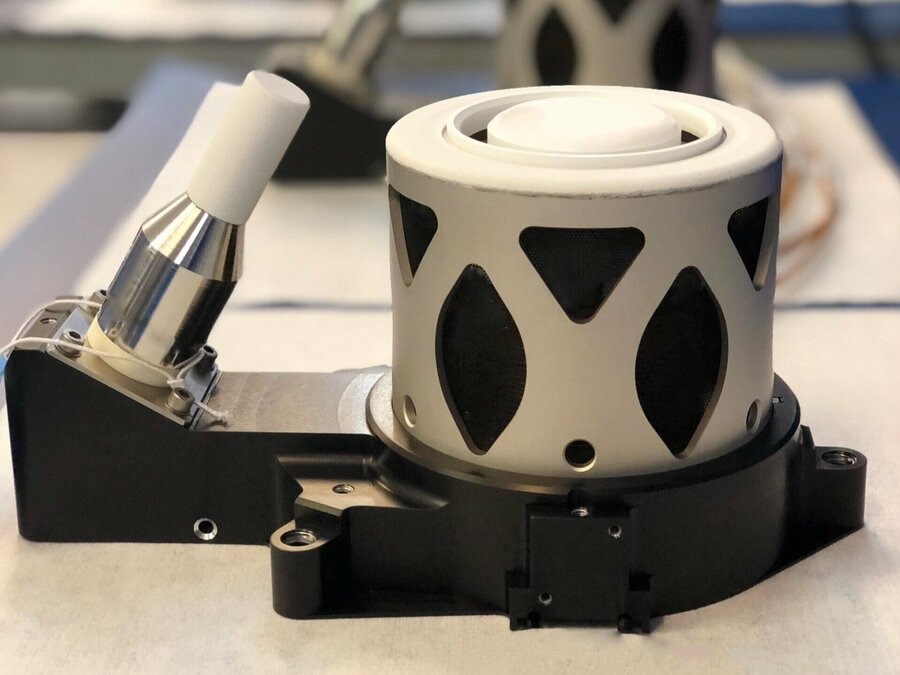To celebrate NASA’s Artemis mission, SBIR/STTR success stories have been chosen by Vertx Partners to highlight select small businesses.

This guide is a special entry in a series that seeks to inform and inspire (read Part 1 here and Part 2 here). This series examines businesses and research institutions that have reaped the rewards of federal contracting. Every year, more and more success stories come out of businesses and their partners utilizing Small Business Innovation Research (SBIR)/Small Business Technology Transfer (STTR) awards to innovate and even change the world.

In this entry, we explore seven small businesses exploring other worlds through the NASA Artemis space program. The Artemis Mission seeks to put humans back on the Moon this decade.
1. Protoinnovations, LLC
As early as the Summer of 2020, NASA eyed Pittsburgh-based Carnegie Mellon spin-off Protoinnovations as a valuable contributor to their Artemis initiative. Founded in 2005, the company focuses on developing robotics and automation for commercial, defense, and space exploration. In the latter category, their work in advanced traction control comes in handy.
On the highly variable terrain of the Moon, Protoinnovations’ work in robotics and rover development will help ensure lunar missions are safe and reliable. Whether for crewed or uncrewed rovers, proper traction on a body with one-sixth Earth’s gravity is paramount for success. Protoinnovations’ work will be put to the test in missions to come.
2. Astrobotic Technology
Another Pittsburgh business, Astrobotic, entered NASA’s radar more recently. However, they will play a similar role to Protoinnovations in developing robotic rovers. Rather than traction control, however, Astrobotic is working to improve power and communications for these special rover missions.
The Moon is a harsh and foreboding environment. Lunar ridges permanently shadow large chunks of the environment at the poles and within deep craters. In these “habitats,” researchers often find precious resources like frozen water, so robust power and communications that can survive these conditions are necessary. With the funding of a Phase II SBIR, Astrobotic developed a technology that can withstand the lunar temperament and relay valuable intel to NASA control.
3. Fibertek, Inc.
Fibertek’s technological aims shoot for the stars – on some level, literally. Rather than the small-scale communication efforts of Astrobotic, this Virginia-based company developed an advanced optical communications system using lasers to transmit large packets of information from lunar landers to lunar satellites and back to Earth.
Because of the sensitivity and pure data load of space missions, quick and efficient communication is essential. With Fibertek’s laser-based intelligence relay, information is transmitted at the speed of light between various arms of the lunar mission to ensure decisions can be made with the precision the mission demands.
4. Deployable Space Systems Inc., A Redwire Company
As part of its Artemis program, NASA is developing the Lunar Gateway. This “apartment-sized” lunar space station will serve as a crewed habitat, laboratory, and staging area for missions to the surface. In order to keep size and weight down, Deployable Space Systems (DSS) developed its Roll Out Solar Array (ROSA) technology. While other solar arrays fold out in an accordion fashion, the ROSA ensures that the Gateway will achieve the compact size its designers aim for.
The SBIR and STTR programs have funded DSS since 2009 to develop ROSA technology. DSS performed validation testing ten years later in 2019. With the success of ROSA, the Gateway now has access to a simple, efficient, and lightweight power source to fuel the advanced operations engaged in by its crew.
5. Busek Company, Inc.
Hall-effect thrusters are like something out of Star Wars. These electric propulsion units are small, lightweight, and precise in the way space missions demand. In keeping with the design philosophy of the ROSA technology, Busek’s thrusters will be powered by solar energy and will be easier to maintain than traditional chemical-based propellants.

Although engineers have used Hall thrusters since the 1970s, Busek acquired SBIR/STTR funding from NASA to develop special thrusters that will keep the Gateway in its highly specific orbital trajectory throughout its lifetime mission.
6. TMC Technologies
NASA’s Artemis Program casts a wide net over the United States to bring together the best and brightest innovators. That net landed in Fairmont, WV, snagging TMC Technologies of West Virginia as a valuable asset to the Artemis initiative. TMC began in 2010 and has grown tremendously with the recent win of a multi-million dollar contract with NASA.
For the Artemis Program, TMC software and systems engineers designed NASA’s first integrated simulation software they’ve dubbed ARRISTOTLE. (That’s “Advanced Risk Reduction Integrated Software Test & Operations Tri-Program Lightweight Environment” for those intrepid enough to memorize the full name.) ARRISTOTLE integrates the NASA Space Launch System (SLS), the Orion Multi-Purpose Crew Vehicle, and the Kennedy Space Center’s Ground Launch Software into “the only high-fidelity integrated environment for the various programs for crewed spaceflight,” according to TMC Chief Engineer, Scott Zemerick.
This program is comprehensive and can be executed on a laptop, giving NASA access to various simulations at a low cost. ARRISTOTLE will prove invaluable to NASA scientists as the Artemis Program progresses.
7. Constellium Rolled Products
For the past 25 years, Ravenswood, WV-based company Constellium Rolled Products has been manufacturing an aluminum alloy destined for the stars. Constellium exclusively produces this proprietary alloy, which they call AirWare. Constellium got involved with the Artemis program through its partnership with Boeing. This partnership helped bring Constellium and its AirWare alloy into the Artemis supply chain.
Engineers don’t just use AirWare for NASA rockets, however. Their versatile metal has found usage in a variety of space companies’ rockets, from Blue Origin to SpaceX. The WV-produced metal’s ubiquity in a variety of space-bound flights has been a source of pride for Constellium workers and CEO Buddy Stemple, who says, “I think it really puts West Virginia on the map and shows what we’re capable of here in this state.”
These are just seven more examples of innovative problem-solving funded in part by the Small Business Innovation Research/Small Business Technology Transfer programs. As you can see, many of these companies started in an Appalachian state, received an SBIR/STTR award, and diversified to other areas through their success. Programs like NASA’s Artemis initiative provide ample opportunities for small businesses to make big contributions. This is just a sliver of the Artemis Mission SBIR/STTR success stories out there.
Vertx Partners will continue to bring you stories of small businesses making big strides with SBIR/STTR funding. Inspired by what you see here? Contact Vertx Partners today with our 6-minute survey, and one of our experts will be in touch within 48 hours.
Become an Innovator With Us
Tell us about yourself, answer a few questions, and hit submit. It’s as easy as that to get started. Did we mention our services are completely free?
